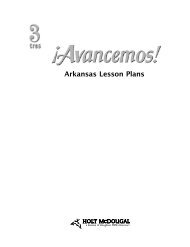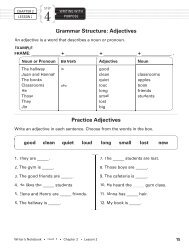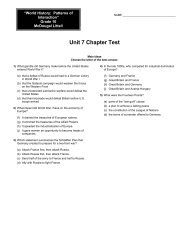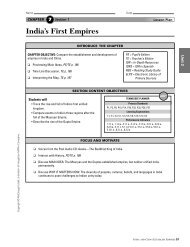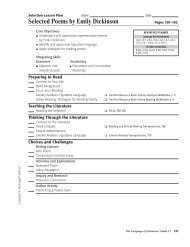Algebra 1 ©2004 - Holt McDougal
Algebra 1 ©2004 - Holt McDougal
Algebra 1 ©2004 - Holt McDougal
Create successful ePaper yourself
Turn your PDF publications into a flip-book with our unique Google optimized e-Paper software.
<strong>McDougal</strong> Littell ALGEBRA 1 correlated to the<br />
New Hampshire Mathematics Curriculum Framework<br />
MATHEMATICS OF CHANGE<br />
7a. K-12 Broad Goal: Students will be able to use concepts about mathematical<br />
change in analyzing patterns, graphs, and applied situations.<br />
PURPOSE: All natural phenomena are characterized by change. Mathematics is a tool for<br />
representing and describing this change, and a preliminary understanding of<br />
change is an important precursor to the more formal ideas of calculus. Through<br />
explorations of patterns, tables, graphs, functions, and situations which focus on<br />
the nature of change, representation, understanding, and recognition of types of<br />
change can be promoted. Real-world examples of change can be examined.<br />
Proportional reasoning and experience with rates should be part of this process.<br />
7-12 Building upon the K-6 experiences, in grades 7-12:<br />
• Use proportional reasoning strategies to solve problems about rates.<br />
TE: 140-143, 645, 647-648<br />
PE: 140-143, 645, 647-648<br />
• Extend patterns and predict nth terms in number sequences.<br />
See <strong>McDougal</strong> Littell <strong>Algebra</strong> 2, pages: 652, 656, 659-660, 662-663, 666-667, 671<br />
• Extend patterns and predict nth terms in sequences of geometric figures.<br />
See <strong>McDougal</strong> Littell Geometry, pages: 5-9, 590-591<br />
• Examine tables of numbers from familiar contexts to determine if patterns exist.<br />
TE: 292-299, 483, 525, 554-559, 663<br />
PE: 292-299, 483, 525, 554-559, 663<br />
• Recognize and describe different types of change (for example: arithmetic, geometric,<br />
periodic, damped, or oscillating).<br />
TE: 293, 297, 423, 460, 467, 477-478, 481-482, 621<br />
PE: 297, 423, 460, 467, 477-478, 481-482, 621<br />
• Calculate and describe change in continuous and discrete contexts which are familiar.<br />
TE: 293, 297, 423, 460, 467, 477-478, 481-482, 621<br />
PE: 297, 423, 460, 467, 477-478, 481-482, 621<br />
33





